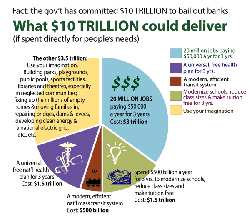
PDF OF PIE CHART
http://www.workers.org/2009/us/10_trillion_0409/
Over the last year, the Bush and Obama administrations have committed almost $10 TRILLION to bailing out banks and other financial institutions that finally crashed after years of raking in extravagant profits. Last September Congress approved the first big bailout plan, the Troubled Asset Relief Program (TARP), to the tune of $700 billion.
There is still no accounting of where all this money has been going.
However, here�s a list of some of the biggest corporations on Wall Street that have already received almost $250 billion in handouts:
BANK OF AMERICA ($45 billion)
CITIGROUP ($45 billion)
AIG ($40 billion)
JPMORGAN CHASE ($25 billion)
WELLS FARGO ($25 billion)
GOLDMAN SACHS ($10 billion)
MORGAN STANLEY ($10 billion)
GM & GMAC ($9.4 billion & $5 billion)
PNC FINANCIAL SERVICES ($7.58 billion)
U.S. BANCORP ($6.6 billion)
CHRYSLER HOLDING & CHRYSLER FINANCIAL
SERVICES ($4 billion & $1.5 billion)
SUNTRUST BANKS ($3.5 billion)
REGIONS FINANCIAL ($3.5 billion)
AMERICAN EXPRESS ($3.39 billion)
BANK OF NEW YORK MELLON ($3 billion)
AND A BEVY OF SMALLER BANKS
(From the Associated Press Bailout Tracker)
It seems all they had to do was hold out their hands and the gold rained down on them.
The fact that the government can even think of promising the money sharks the mind-boggling sum of $10 trillion shows how tremendously productive U.S. workers have been�and could be again if jobs were available producing what people need.
As workers, we need to think about how we would spend such vast resources in order to directly ease the crisis for the millions now facing desperate conditions. If workers, instead of bankers like Treasury Secretary Timothy Geithner and Fed Chairperson Ben Bernanke, were really in control and could plan the economy, wouldn�t we put jobs and services first? Here are a few ideas on how that could be done.
A REAL JOBS PROGRAM
With just $1 trillion out of the $10 trillion the government is giving to the financial elite, we could create jobs for 20 million people a year at a salary of $50,000 each. Spend $3 trillion over three years and we could wipe out unemployment and underemployment in this country.
Workers in many public services are terribly overworked. Let�s shorten the workweek (with no cut in pay) for those already employed and put those 20 million new hires on the payroll to do the many things that are needed to improve the schools, provide health care, transportation, clean the environment and so on.
After spending $3 trillion on wages for our new jobs program, we�d still have $7 trillion left.
HEALTH CARE
Britain will spend about $131 billion on its National Health system this year, which guarantees health care to everyone, most of it free. The total amount spent on health care in the U.S. last year, both public and private, was $2.19 trillion. The U.S. has roughly three times as many people as Britain, so with a similar national health system it should be able to cover everyone for much less than is spent now�about $400 billion a year.
But let�s be generous. The government should easily be able to set up a quality national health system that is free and affordable, and not based on profits, for half a trillion a year. This would actually save the people of this country more than $1.5 trillion a year while making us healthier.
Despite all the money now spent on health care, the U.S. ranks below Britain and almost all other developed countries in life expectancy and the survival rate of infants and children�two key indicators of the health of the population.
Three years of national health would cost $1.5 trillion. That leaves $5.5 trillion.
MASS TRANSIT
Facing high gas prices and worries about air pollution and climate change, more people than ever have been taking mass transit. In the U.S., people made 10.7 billion trips on public transit in 2008 and drove less. Shouldn�t the government be encouraging this? But instead, state and local funds for mass transit are being cut drastically. Trains, buses and subways are being allowed to deteriorate and workers are being laid off. The result is crowded buses and trains, long waits, frequent breakdowns and steeply higher fares�which will drive many riders back to private cars, if they can afford them.
The Obama administration stimulus package contains just $8.6 billion for improving existing mass transit, mainly by replacing old buses with more energy-efficient ones. It contains another $8 billion for high-speed rail service, which will do little for inner-city commuters who have to put up with service cuts and higher fares.
Think of what it would mean if, instead of $16.6 billion, the government got serious and spent $500 billion over three years on improving mass transit: cleaner air, faster commuting times, more jobs, lower fares. And the auto workers now being laid off could be hired to build efficient, speedy buses.
That leaves $5 trillion.
EDUCATION
The stimulus package provides more than $100 billion for early childhood, K-12 and higher education over the next two years. However, state budgets are in such a crisis that they are still cutting school programs, laying off teachers and raising tuition at the college level. The public schools have deteriorated, especially in inner cities, where the buildings are old, there are not enough books, and class sizes are large. An infusion of $500 billion a year from the federal government to improve the schools would turn this around.
That leaves $3.5 trillion.
These figures are all arbitrary. But you get the idea. There�s plenty of wealth in this country to end the crisis and get everyone working again with a roof over their head and health care, transportation and education they can rely on.
What are we waiting for? Let�s organize, organize, organize and fight for it!
Text
Articles copyright 1995-2009 Workers World. Verbatim copying and distribution of this entire article is permitted in any medium without royalty provided this notice is preserved.
SOURCE ARTICLE
http://www.workers.org/2009/us/10_trillion_0409/